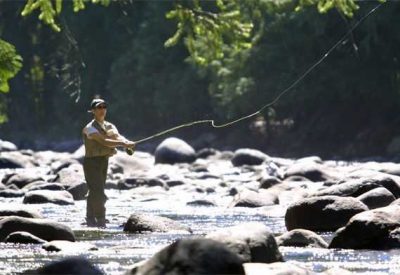by Rene Hesse
There are a lot of different casts to use in the wind. There are a lot of different names for the same wind cast that I am about to explain.
This is a VERY useful cast that you can use for a windy day. Use it when you are on a boat and the wind is coming in to your casting arm. It’s dangerous when the wind is pushing the line at you from the side as you make your back and forward cast. This cast is also super helpful when you are on a stream and have trees scattered behind you as you try to cast to the other side of the stream.
One name for the cast is a Barnegat Bay cast. Growing up in Missouri in the 60’s and 70’s and having no fly casting coaching or material to read, I just called it a back cast. In fact, I really didn’t call it anything, we just did it. I wish I knew the tweaks then that I know now.
I’m going to tell you an easy way to adjust your cast by changing only one variable and then tell you a really cool way to use the cast. The main variables in a fly cast that we control are; stroke size, power application, timing and trajectory. The only one of those that we need to adjust on a back cast delivery is the trajectory. Here is how it works and how I use it quite often on our North Georgia streams.
We think of this is a wind cast, however it can be used anytime. Works really good for tight places.
Standing in the stream or on the side of the stream with the water going from left to right (That is called a river right position.) and the wind is going right to left (That would be an upstream wind). For a right hand caster it would mean the wind is coming at your right arm and could cause the fly line to be coming close to your body. In this situation, turn your back to the wind so you’re are now facing upstream. Now you are in position to make the back cast delivery, and here is how the cast gets really cool.
Pick out a hole in the trees in a place that you can cast your line through, ideally 180 degrees from your target or as close as you can to that. The goal will be to use your excellent casting skills to make a ‘forward cast’ into the empty space in the trees at an upward trajectory so you can extend line, and then don’t change anything, and deliver the fly on the back cast at a lower trajectory.
Turn your back to the wind, pick out a spot or area that you can make a forward cast into and then deliver your fly to the target on the back cast. That’s it. Don’t make it any more complex.
Taking time to practice that cast on land, using targets and obstructions will help a great deal. Focus on making a cast away from the target in an upward trajectory and make the back cast to the target, not up. Whatever you want to call the cast is up to you. The bigger thing is knowing when to use it and how.

